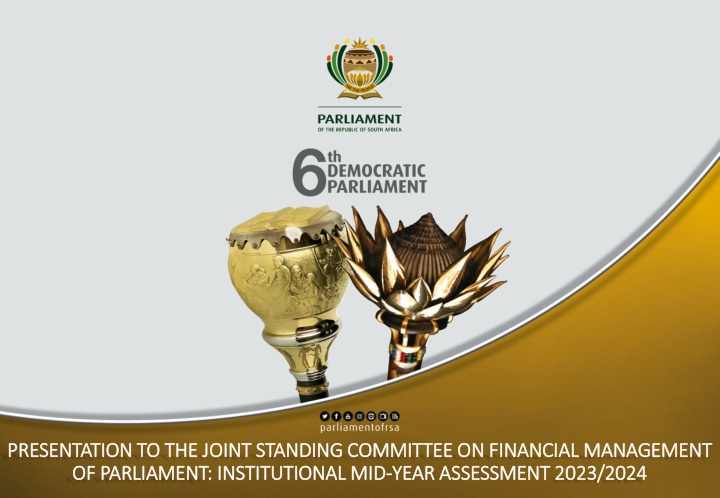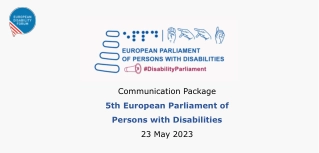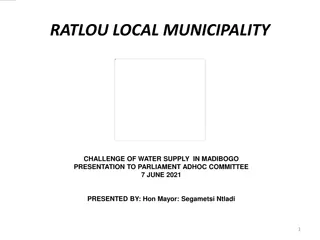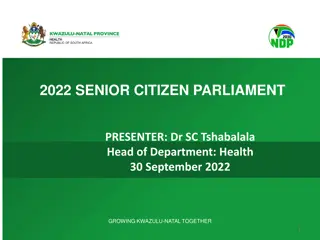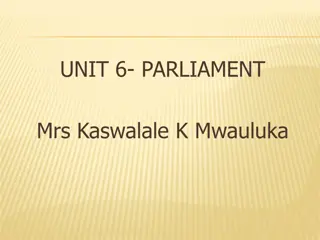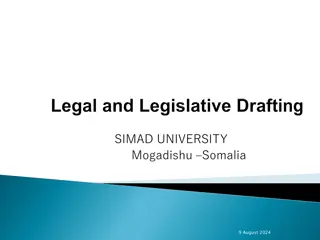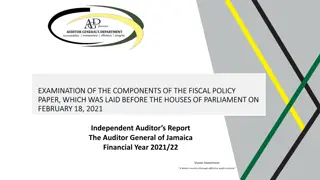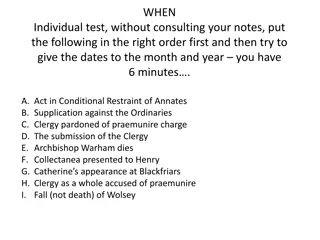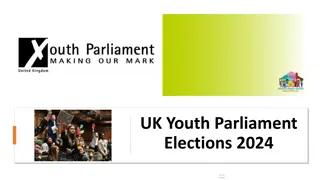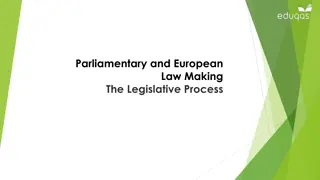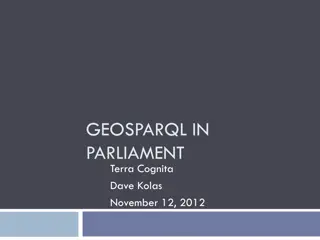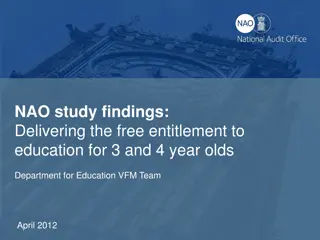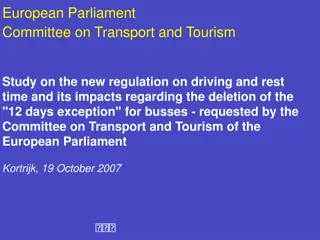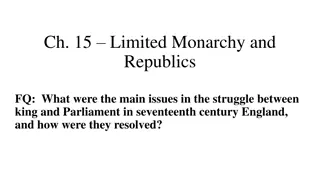Mid-Year Assessment 2023/2024: Financial Management of Parliament Presentation
Presentation to the Joint Standing Committee on Financial Management of Parliament for the Mid-Year Assessment 2023/2024. The assessment covers purposes, progress review, human resources, governance, financial assessment, insights, lessons learned, and recommendations for the second half of the year, aligning with the requirements outlined in the Financial Management of Parliament and Provincial Legislatures Act, 2009.
Download Presentation

Please find below an Image/Link to download the presentation.
The content on the website is provided AS IS for your information and personal use only. It may not be sold, licensed, or shared on other websites without obtaining consent from the author.If you encounter any issues during the download, it is possible that the publisher has removed the file from their server.
You are allowed to download the files provided on this website for personal or commercial use, subject to the condition that they are used lawfully. All files are the property of their respective owners.
The content on the website is provided AS IS for your information and personal use only. It may not be sold, licensed, or shared on other websites without obtaining consent from the author.
E N D
Presentation Transcript
PRESENTATION TO THE JOINT STANDING COMMITTEE ON FINANCIAL MANAGEMENT PRESENTATION TO THE JOINT STANDING COMMITTEE ON FINANCIAL MANAGEMENT OF PARLIAMENT: OF PARLIAMENT: INSTITUTIONAL MID INSTITUTIONAL MID- -YEAR ASSESSMENT YEAR ASSESSMENT 2023/2024 2023/2024
Mid Mid- -Year Assessment Year Assessment 1. Purpose of the Mid-Year Assessment 2. 3. 4. Informing the work of Parliament Environmental Context Review of Progress 5. 6. 7. 8. 9. Human Resources Governance Report Financial Assessment Insights and Lessons Learned Recommendations for the Second Half of the Year
1. Purpose of the Mid-Year Report
Purpose of the Mid Purpose of the Mid- -Year Year The Financial Management of Parliament and Provincial Legislatures Act, 2009 (FMPPLA, Act No. 10 of 2009) Section 53 (1) states that, before 31 October of each year, the Accounting Officer must submit to the Executive Authority a report (i.e. mid- year budget and performance assessment) that assesses the performance of Parliament s administration during the first half of the financial year . The Accounting Officer is further obligated by Section 53 (1) to recommend adjustments to the budget if necessary; and to revise projections for revenue and expenditure where appropriate. The mid-year report must be tabled by the Executive Authority in Parliament within five (5) working days of receiving the report according to Section 54 (1) of the FMPPLA (Act 10 of 2009). 4
2. Informing the work of Parliament Socio Analysis
The Constitutional imperative: Preamble Heal the divisions of the past and establish a society based on democratic values, social justice and fundamental human rights; Improve the quality of life of all citizens and free the potential of each person; Lay the foundations for a democratic and open society in which government is based on the will of the people, and in which every citizen is equally protected by law; Build a united and democratic South Africa that is able to take its rightful place as a sovereign state in the family of nations. 6
Parliaments Mandate Section 42 (3) and (4) of the Constitution: The National Assembly is elected to represent the people and to ensure government by the people under the Constitution. It does this by choosing the President, by providing a national forum for public consideration of issues, by passing legislation and by scrutinizing and overseeing executive action. The National Council of Provinces represents the provinces to ensure that provincial interests are taken into account in the national sphere of government. It does this mainly by participating in the national legislative process and by providing a national forum for public consideration of issues affecting the provinces. 7
Legislative Framework for Reporting 1. Regular reports provide information for oversight and accountability purposes, within the management cycle of planning, budgeting, resourcing, and execution of the institution s strategy. 2. Section 52 of FMPPLA requires that the Accounting Officer, within 30 days of the end of each quarter, report on Parliament s performance in implementing the annual performance plan, to the Executive Authority. 3. Section 54 requires the Executive Authority to table reports, and to refer these to the oversight mechanism. 8
3. Environmental Context Socio Analysis
Context It is presented against the backdrop of significant positive gains achieved since the dawn of democracy on such issues as: Provision of water and sanitation Improved access to electricity Housing and public health Improved access to education at basic, higher and tertiary Persistent weak economic environment, stubborn unemployment, inequality, poverty, and declining quality of governance and poor service delivery. A global economic downturn 10
National Development Plan priorities StatsSA; DPME Report **CIA World Fact Book (0,63) *https://www.statista.com/statistics/1263290/number-of-people-living-in-extreme-poverty-in-south-africa/ 11
4. Review of Progress
Measuring Progress ON TRACK Performance is above target on both quarters
Progress Summary Progress Summary 30% 63% 7% Lagging 9 Indicators In Progress 2 Indicators On Track 19 Indicators 15
Progress Summary Progress Summary by Programme by Programme 11% 11% 38% 5% 78% 57% Programme 1 Programme 2 On track 7 12 In Progress 1 1 Lagging 1 8 Programme 1: Administration Programme 2: Legislation & Oversight 16
Progress Summary Progress Summary by Target by Target 11% 42% 11% 100% 89% 47% Transformational Service Programming On track 9 8 2 In Progress 2 0 0 Lagging 8 1 0 Transformational Targets Service Targets Programming Targets 17
Transformative Parliament New macro framework Transformative Parliament Stakeholder- centric Parliament Responsive Parliament Caring Parliament Intervening Parliament Collaborative Parliament Operational excellence 18
Progress on Macro Framework Progress on Macro Framework On Track 1 1 0 1 2 n/a In Progress 1 0 2 0 2 Lagging 4 0 1 1 1 Transformative Responsive Collaborative Stakeholder-centric Operational Excellence Caring n/a Intervening Transformative 5% 5% 20% Responsive 5% Collaborative 10% 5% Effective Stakeholder Engagement 5% 5% Operationsl Excellence 10% 10% 5% 19
Progress on Programming & Service Progress on Programming & Service On Track 2 6 In Progress 0 0 Lagging 0 1 Programming Indicators Service Indicators Programming Indicators 86% 14% Service Indicators 100% 20
Performance Status Q1 Q2 STATUS Develop and implement an Oversight Priority Model to ensure focused oversight Performance Analysis: Data collection report in progress, template completed, and formalization of a multi-sectoral task team. Overall target not met, possibly due to the delayed start in Quarter 1. Corrective Measures: Analytical research paper on data insights expected submission on 24 November 2023. Scheduled standing workstream meetings to accelerate progress during Q3 and Q4. Implemented more stringent monitoring and evaluation and regular reporting for real-time troubleshooting and corrective action. Transformational Parliament 21
Performance Status Q1 Q2 STATUS Develop and implement a Committee planning framework to align committee oversight with oversight focus areas Performance Analysis: Target not met due to delayed appointment letters. First draft framework for Committee PBR and M&E in progress. Target not met due to a lack of project support in monitoring teams and ensuring compliance with timelines. Corrective Measures: The finalization of team appointment has been expedited, and communication and coordination is being improved to ensure teams are aware of their responsibilities and timelines. The consideration of the 2024/25 APP presents an opportunity to reevaluate and adjust project timelines and assess resource allocation to ensure that teams have the necessary support and tools to complete tasks on time. We have established a process of regular quarterly review meetings to discuss progress, challenges, and potential improvements. This provides an opportunity to address issues and adjust strategies as needed. Transformational Parliament 22
Performance Status Q1 Q2 STATUS Develop and implement a country indicator dashboard supporting the measurement of outcome progress towards attainment of the NDP impacts Performance Analysis: Progress in concept development, consultation, template completion, and data collection. Overall target not met, ongoing formalization of the multi-sectoral task team. Transformational Parliament Corrective Measures: This target is aligned to the Oversight Priority Model (Plan). Analytical research paper for completion by 24 November 2023. 23
Performance Status Q1 Q2 STATUS Implement data modelling and scenario tools to improve the quality of oversight Performance Analysis: Target not met due to delays in formalizing the multi-disciplinary team. Overall target not met due to delays in signing the MOU and competing operational demands. Corrective Measures: The finalization of team appointment has been expedited, as well as the legal vetting of the MOU to enable its timely signing. Coordination is being improved to align operational demands and facilitate smoother project implementation. We have established a process of regular quarterly review meetings to discuss progress, challenges, and potential improvements. This provides an opportunity to address issues and adjust strategies as needed. Transformational Parliament 24
Performance Status Q1 Q2 STATUS Develop an impact assessment framework for Bills Performance Analysis: Multi-disciplinary team not established and target not met in Q1. Research report on best practices produced, meeting the target. Corrective Measures: The positive momentum from Quarter 2 ensured progress in the development of the impact assessment framework. The multi-disciplinary team was established and knowledge sharing was encouraged within the team to leverage diverse expertise and insights in the development of the impact assessment framework. We have established a process of regular quarterly review meetings to discuss progress, challenges, and potential improvements. This provides an opportunity to address issues and adjust strategies as needed. Transformational Parliament 25
Performance Status Q1 Q2 STATUS Develop and implement an Oversight monitoring and tracking mechanism Performance Analysis: Concept for the oversight monitoring and tracking system developed, meeting the target. Produced a benchmark report and finalizing specifications for the committee dashboard. Corrective Measures: We have capitalised on the positive momentum and success to enhance motivation and commitment. An iterative development approach was engaged, allowing for ongoing adjustments based on feedback and changing requirements. Transformational Parliament 26
Performance Status Q1 Q2 STATUS Implementation of recommendations made by the Commission on State Capture to strengthen oversight Performance Analysis: Quarterly report on the implementation of the President's Plan completed, meeting the target. Rules Committee considered recommendations referred to it, meeting the target. Corrective Measures: We have established the practice of regular reporting against agreed timelines to monitor the ongoing implementation of recommendations. Responsive Parliament 27
Performance Status Q1 Q2 STATUS Develop a new partnership framework on oversight Performance Analysis: Target not met, with the Q1 target transposed to Q2, and the research report to be finalized later. Corrective Measures: We have identified specific challenges and obstacles that led to the targets not being met. Project timelines and being reassessed and adjusted. We have established a process of regular quarterly review meetings to discuss progress, challenges, and potential improvements. This provides an opportunity to address issues and adjust strategies as needed. Collaborative Engagement 28
Performance Status Q1 Q2 STATUS Review of support for Constituency Offices Performance Analysis: Review report on support for constituency offices completed. Benchmarking report on international support for constituency offices not completed and submission delay due to a lack of project support for timeline compliance. Corrective Measures: We are considering a realistic reassessment of project timelines. We are also enhancing communication within the project team to ensure that everyone is aware of their responsibilities and timelines. We have established a process of regular quarterly review meetings to discuss progress, challenges, and potential improvements. This provides an opportunity to address issues and adjust strategies as needed. Collaborative Engagement 29
Performance Status Q1 Q2 STATUS Review Parliament s strategy and capability to implement its international priorities aligned to the national agenda. Performance Analysis: Draft position paper for the review of Parliament's international engagement policy is complete. The report on international priorities, obligations, and commitments was not submitted and no information is provided on the target. Corrective Measures: We have established clear reporting procedures to ensure that reports on completed tasks are promptly submitted and have defined responsibilities and timelines for report submissions and clearly define and report targets for each quarter. We have established a process of regular quarterly review meetings to discuss progress, challenges, and potential improvements. This provides an opportunity to address issues and adjust strategies as needed. Collaborative Engagement 30
Performance Status Q1 Q2 STATUS Implement a new stakeholder framework ensuring participation and cooperation Performance Analysis: The target was not met, with the draft Concept Document on Cooperation completed but not the implementation of the stakeholder framework. The target of developing the draft framework was not met, and the reason for the variance is not provided. A workshop was held with stakeholders, but its impact on achieving the target is not clear. Corrective Measures: We have identified bottlenecks and challenges that hindered the implementation of the stakeholder framework in both quarters. We have established a process of regular quarterly review meetings to discuss progress, challenges, and potential improvements. This provides an opportunity to address issues and adjust strategies as needed. Effective Stakeholder Engagement 31
Performance Status Q1 Q2 STATUS Develop and implement a petitions framework Performance Analysis: Research and benchmarking for the petitions framework were undertaken, and additional progress was made with the development of petitions guidelines, which are under consideration by the Subcommittee on Review of Assembly Rules. Corrective Measures: We have built on the positive momentum gained in Quarter 1 and 2. We have also established a process of regular quarterly review meetings to discuss progress, challenges, and potential improvements. This provides an opportunity to address issues and adjust strategies as needed. Effective Stakeholder Engagement 32
Performance Status Q1 Q2 STATUS Improve public trust and confidence in Parliament Performance Analysis: A new research cycle was initiated, indicating a proactive approach to improving public trust and confidence in Parliament. The target for Quarter 1 was not met due to a delay in appointing the service provider for the research. Submission of an Analytical Report on recommendations to improve public trust Corrective Measures: We have engaged with relevant internal stakeholders to gather input and feedback on strategies to improve public trust. Involving key stakeholders ensures a more comprehensive and effective institutional strategy. We have established a process of regular quarterly review meetings to discuss progress, challenges, and potential improvements. This provides an opportunity to address issues and adjust strategies as needed. Operational Excellence 33
Performance Status Q1 Q2 STATUS Development of a broadcasting strategy for the 7th Parliament Performance Analysis: The target for the Development of a Broadcasting Strategy for the 7th Parliament was deferred and not met. The draft was circulated, followed by multi-stakeholder consultation, but the strategy took longer to draft due to delays in the Public Broadcasting Bill. The target for Quarter 2 was not met, as the TV & radio Broadcast Strategy and system were not approved, and the investment in new broadcast and multimedia technologies to improve the quality of public TV communication was not implemented. Preparatory work was done on this target. Corrective Measures: We have assessed the adequacy of preparatory work for alignment with the project's goals. We have established a process of regular quarterly review meetings to discuss progress, challenges, and potential improvements. This provides an opportunity to address issues and adjust strategies as needed. Operational Excellence
Performance Status Q1 Q2 STATUS To Professionalise the Parliamentary Service Performance Analysis: The target for professionalizing the Parliamentary Service for all three components: new implementation plan for realignment project, change management implementation plan, and policy review implementation plan. Review of the realignment plan, analysis for change management, and stakeholder engagements for policy review were all completed. Drafts were developed for the new implementation plan, change management program and plan, and policy review implementation plan. Corrective Measures: We have sustained the positive momentum is crucial for the overall success of the professionalization initiative. We will continue to monitor the progress of the initiatives as they move from the draft stage to final implementation. Operational Excellence 35
Performance Status Q1 Q2 STATUS Implement the plan for the restoration of Parliamentary buildings Performance commendable progress, achieving 95% physical completion of 155 offices. Despite success in the viability report and SDP, SAHRA heritage approval faced delays due to prolonged stakeholder engagement and stringent requirements. To mitigate, ongoing fortnightly engagements with SAHRA are crucial. Financial resource utilization saw a -11% variance, attributed to Quarter 1 delays and unforeseen damages to the Old HVAC system. Corrective Measures: We have improved open and transparent communication with stakeholders is vital, ensuring all parties are informed of progress, challenges, and mitigation strategies. We have established a process of regular quarterly review meetings to discuss progress, challenges, and potential improvements. This provides an opportunity to address issues and adjust strategies as needed. Analysis: the Restoration Management Plan exhibited Operational Excellence 36
Performance Status Q1 Q2 STATUS Shift towards outcome and impact-driven business analytics using big data Performance Analysis: The shift towards outcome and impact-driven business analytics using big data commenced with the successful development and submission of the Data Management Policy. The positive trend continued in Quarter 2 with the completion of a diagnostic assessment report of structured data and the successful development of the Data Management Policy. Both targets for Quarter 2 were met. Corrective Measures: The Data Management Policy serves as a foundation for future analytics projects. We have established a process of regular quarterly review meetings to discuss progress, challenges, and potential improvements. This provides an opportunity to address issues and adjust strategies as needed. Operational Excellence 37
Performance Status Q1 Q2 STATUS Number of annual parliamentary frameworks adopted Number of NA programmes adopted Number of NCOP programmes adopted Programming Indicators Performance Analysis: The targets for the Number of National Assembly and National Council of Provinces programs adopted were both met. Corrective Measures: Parliamentary programming provides the basis for effective implementation of Parliament s mandate. We will continue to engage with relevant stakeholders, including members of the National Assembly and National Council of Provinces, to gather input on programming priorities. 38
Performance Status Q1 Q2 STATUS % Member satisfaction (Capacity building service) % Member satisfaction (Research service) % Member satisfaction (Content advice service) % Member satisfaction (Procedural advice service) % Member satisfaction (Legal advice service) % Member satisfaction (Committee support service) Service Indicators % Member satisfaction (Public participation service) Performance Analysis: All services experienced an increase in member satisfaction, ranging from +1.42% to +7.48%. Public Participation Service experienced a significant decrease in satisfaction at -4.68%, with the lowest dimension being fair, objective, and non-partisan service in Q2. Corrective Measures: Implementation of our public participation programmes is being improved. We have also established a process of regular quarterly review meetings to discuss progress, challenges, and potential improvements. This provides an opportunity to address issues and adjust strategies as needed. 39
5. Human Resources
Human Resources Human Resources Talent Retention Parliament s low attrition rate (voluntary, involuntary or retirement) with a turnover rate of 0.08% this quarter against a target of 5%. Graduate Programme: Facilitating Voluntary Early Retirement Dispensation(VERD): MoU with South African Council of Graduates concluded. Conducted a cost benefit analysis in collaboration with actuaries. Additionally the PSOP offering has been reviewed. Of the GEPF members eligible for early retirement 15 employees have expressed interest in applying for retirement. 93% of graduates concluded performance contracts & 60% completed Personal Development Plans Culture: Talent Acquisition: Learning: A diagnostic report, strategic change projects & culture change priorities areas Identified. A change management programme & plan have been developed There were 20 appointments, of which 9 were internal and 11 were new hires. 172 employees participated in training interventions 41
6. Governance
Reporting & Advisory Forums Forum Executive Authority Committee (EA) Meetings held 14 April 2023 5 May 2023 12 June 2023 11 August 2023 18 September 2023 PARLIAMENTARY REPORTING FORUMS Executive Committee (EXCO) Secretariat 2 May 2023 8 September 2023 15 September 2023 25 July 2023 26 July 2023 30 August 2023 17 April 2023 21 July 2023 5 April 2023 7 July 2023 No meeting held CONSULTATIVE AND ADVISORY PARLIAMENTARY FORUMS Management Team Risk Management Committee Risk Management Forum Policy Committee Audit Committee 27 July 2023 43
Mid-Year Report on FMPPLA Indicator Submission March 2023 MFS Tabling of March MFS Submission of the 4th Quarter Report Planned 15 April 2023 22 April 2023 30 April 2023 Actual 14 April 2023 20 April 2023 02 May 2023 Compliant APRIL 2023 Indicator Tabling of the 4th Quarter Report Planned Actual Compliant 5 May 2023 4 May 2023 Submission of April MFS 15 May 2023 12 May 2023 MAY 2023 Tabling of April MFS 22 May 2023 19 May 2023 Submission of 2024/2024 APP 31 May 2023 25 May 2023 JUNE 2023 Indicator Planned Actual Compliant Submission of May MFS 15 June 2023 14 June 2023 Tabling of May MFS 22 June 2023 19 June 2023 Indicator Submission June 2023 MFS Tabling of June 2023 MFS Submission of the 1st Quarter Report 2023/24 Planned 14 July 2023 21 July 2023 31 July 2023 Actual 9 July 2023 20 July 2023 31 July 2023 Compliant JULY 2023 Indicator Tabling of the 1st Quarter Report 2023/24 Submission of July 2023 MFS Tabling of July 2023 MFS Submission of the 2022/2023 Annual Report Planned 7 August 2023 15 August 2023 21 August 2023 31 August 2023 Actual 4 August 2023 10 August 2023 17 August 2023 25 August 2023 Compliant AUGUST 2023 SEPTEMBER Indicator Tabling of the 2022/23 Annual report Submission of August 2023 MFS Tabling of August 2023 MFS Planned 22 September 2023 15 September 2023 22 September 2023 Actual 31 August 2023 14 September 2023 20 September 2023 Compliant 2023 44
Financial Performance: Appropriation Statement by Programme 46
Financial Performance: Appropriation Statement by Programme 47
Financial Performance: Appropriation Statement by Programme 48 2ND QUARTER 2023 JULY TO SEPTEMBER 2023 R'000 ANNUAL R'000 Annual Budget Budget available MAIN DIVISION Budget Actual Varience % Actual % Administration Legislation & Oversight Associated Services 210 772 257 239 194 366 210 258 254 582 195 893 514 2 657 (1 527) 100% 99% 101% 988 091 924 037 830 724 385 013 453 884 403 694 603 078 470 153 427 030 39% 49% 49% SUB TOTAL 662 377 660 733 1 644 100% 2 742 852 1 242 591 1 500 261 45% Direct Charges 133 250 149 897 (16 647) 112% 471 709 285 367 186 342 60% TOTAL (EXCLUDING DISASTER FUND) 795 627 810 630 (15 003) 102% 3 214 561 1 527 958 1 686 603 48% Captial (Disaster Fund) 68 101 67 862 239 100% 1 136 924 74 983 1 061 951 7% TOTAL 863 728 878 492 (14 764) 102% 4 351 485 1 602 941 2 748 554 37% Appropriated budget The Expenditure incurred to date in comparison to the Annual Budget shows a 48% spending for the 6-month period when the Disaster Fund is removed from Progamme 1 to provide a more realistic assessment of the financial performance. Overall spending for Quarter 2 has resulted in a 2% overspending due to higher-than-expected Direct Charges of R16,6 million as well as in Associated Services of R1,5 million during the July to September 2023 period. The overspending in Direct Charges will be charged against the National Revenue Fund at year end. The overspending in Associated Services will be reviewed during the Budget Adjustment period to ensure corrective action is taken.
Financial Performance: Appropriation Statement by Programme Appropriated budget Parliament has spent 102 percent or R878,4 million of its appropriated budget of R863,7 million for the second quarter. It is projected that the full appropriated budget will be full spent at end of the year, except the budget for rebuild of Parliament. There is projected underspending of 710,5 million of the on the restoration and rebuilding of Parliament budget due to delays experienced in implementation of the project, the amount will be used in following year on this project. Details of the spending patterns per main division are provided under programme performances below. Direct Charges The spending on direct charges is R149,8 million or 111 percent of the second quarter budget of R133,2 million. The overspending is attributable to the payment of the loss of office gratuities over and above the payment of Members' salaries. There is projected overspending of R67,4 million at the end of the financial year, which is attributable to the increase in salaries of Members for the 2022/23 financial year, the payment of loss of office gratuities & exit gratuities and to the budget reductions. This projected overspending will be a direct charge against the National Revenue Fund in line with section 23(4) of the FMPPLA. 49
